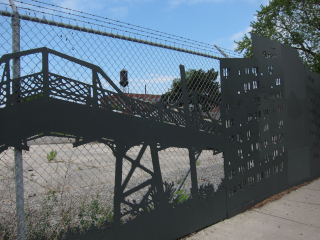Attention
The Psychological Value of Public Art
Public art can be a powerful tool for city building.
Posted January 15, 2015

When we walk through city streets, we often feel as though we are immersed in our own worlds, thinking about where we’re going, where we’ve been, rushing to complete the day’s chores, immune to the panorama of sensory experiences that envelop us as we strut hurriedly from one place to another. Yet even in our most distracted moments, our minds are buffeted by our surroundings. What we see, hear, feel beneath our feet and smell in the air influences what we think and how we feel. Our sensory surroundings can even sometimes be read from the quality of our movements—our gait, posture, and the pattern of quick glances that we make from one feature of our surroundings to another.
A few months ago, I experienced one of those wonderful moments of serendipity that brought together several of life’s great joys: a good walk, good food, and a great surprise. I was in the great city of Toronto, hungry for breakfast and looking for a feast of waffles at a renowned city eatery that I’d heard about from friends. On the way there, I stumbled on something unexpected. In the middle of a dense part of the city, I encountered a bare field of gravel so large that it could have housed a good game of football. The field, populated by nothing more than a few scrubby weeds, was a surprising find all by itself, but what made me stop in my tracks was the chain-link fence that surrounded it. This was no ordinary fence. It was covered with artful shapes made from simple sheets of plywood and painted black. The shapes showed trees, plants, flocks of birds taking flight, people waiting at a bus stop, silhouettes of buildings, factories, towers and bridges. As I looked through the fence I could see open air, a distant skyline of industrial buildings that seemed to resonate nicely with the depictions of buildings shown in the decorations. The art transformed my experience of the street. I felt curious, lively, amused and excited. I stopped, looked around in wonder as if trying to glean more clues as to the meaning of what I was seeing.
Another lucky triangulation on that day was that I had just been asked to give a presentation at a conference whose focus was on the design of construction sites. The organizer had suggested that I might talk about the psychology at play when an urban dweller has to live among the construction sites and sidewalk sheds endemic to big cities. Without really knowing what I was getting into, I agreed to give the presentation and I decided that I would also see if I could put together some kind of illustrative example or case study showing the power of street design to influence pedestrian behavior. When I stumbled upon the fence, I realized that I had found my study site.
I tracked down the artists who had designed the fence and, over delicious waffles, one of them, Scott Eunson, filled me in on the back story. The site had been the previous location of an old streetcar roundhouse that had been torn down to make way for a newer structure, but, upon testing, it was found that the ground was permeated with industrial chemicals that would need to be cleared up before construction could take place. Because this was going to take quite a long time (and, indeed, after four years, the work seems not to have even started yet as logistics and legalities continue to be worked out), the city commissioned a contest to decorate the site and Eunson and his work partner Marianne Lovink were the winners.
For my study, I used the time-honored methods of simple observation pioneered by urbanists like William Whyte and Jan Gehl. I hired a student who spent her days sitting at one or the other end of the fence, watching passersby. She measured their walking speeds, their patterns of gaze (just how often they looked at the fence or at the roadway) and the number of times that they paused enroute from one end of the fence to the other. For comparison, we selected another nearby chain link fence surrounding a construction site but this one was unadorned with art.
The results of our simple study were astounding. Not only did pedestrians glance more often at the art fence (which was hardly a surprising result), but their walking pace decreased significantly. A very broad rule of thumb for urban walkers is that their average pace is about 5 km (or just over 3 miles) per hour. At the control site, that was exactly the value that we found. At the art fence, the pace of walking had dropped to about half of this value by the time walkers reached the end of the fence, and this was true regardless of the direction that they walked (north to south or south to north) and the time of day. The main finding is shown in the figure below. This fact is all the more remarkable when one considers that the fence that had been in place for years, and that presumably many of our walkers had experienced the fence on a daily basis hundreds and hundreds of times before our measures.

This simple experiment and its convincing result shows the great power of public art to influence how we move, think and feel in city environments. If such a clear result can be obtained for a fence surrounding a field of poison gravel, then what are the greater possibilities for enhancing city life through thoughtful treatment of the facades, building skins, and walkways that we use as we move about the city? We may sometimes feel that installations of public art are nothing more than aesthetic baubles. But this fence, and the simple study I’ve described, show that good installations can reach inside our minds and exert profound effects on our behavior. Public art can be a powerful tool for building better cities.
If you’d like to know more details about the fence and the experiment, you can find my presentation on the psychology of construction sites here.
For updates, follow me on Twitter.


